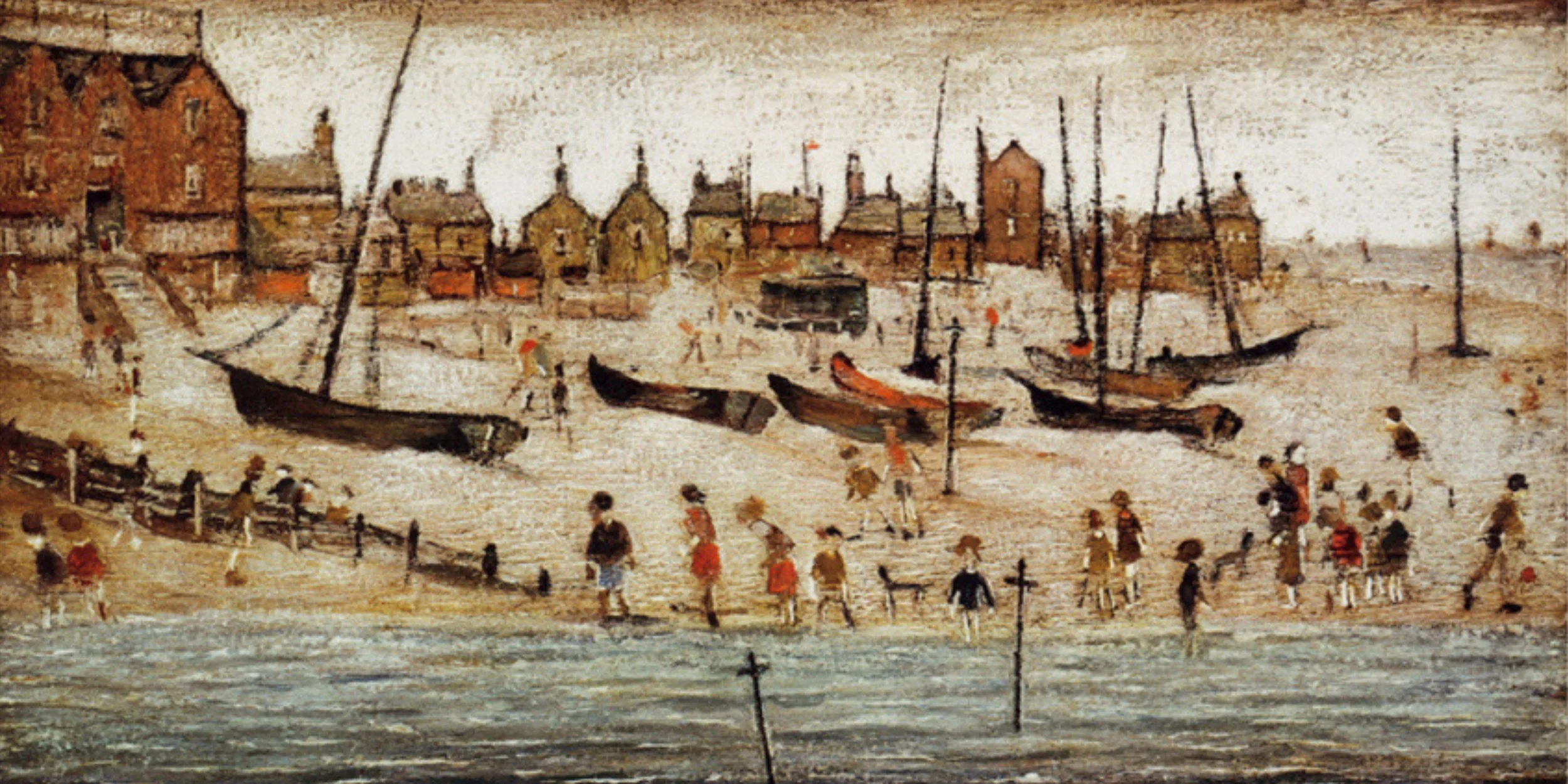L.S Lowry - Biography
Laurence Stephen Lowry (1 November 1887 – 23 February 1976) was an English artist, famous for painting scenes of life in the industrial districts of Northwest England in the mid-20th century, mainly depicting Pendlebury, Lancashire (where he lived and worked for more than 40 years) as well as Salford and its vicinity. He developed a distinctive style of painting peopled with human figures, often referred to as 'matchstick men':
“All I do, as I said before, is I paint the figures as I see them. They may be like matchsticks, they be like anyway you like, but I just do them as I like to see them”.
Lowry used his paintings as a form of self-discovery, therapy and understanding of the human nature. His complex nature is key to his stylistic figurines, in which one sees a sort of extended self-portraiture.
Although best known for his mill scenes and industrial landscapes, Lowry’s work covers a wide range of themes and subjects, from landscapes and seascapes to portraits and surreal imaginings. He painted mysterious unpopulated landscapes, troubled and gloomy portraits, as well as the unpublished "marionette" works, which were only discovered after his death in 1976.
Early Life
A major turning point in his childhood was the necessity of moving from a leafy suburb of south Manchester to a highly industrial area called Pendlebury due to financial reasons. He studied painting and drawing in the evenings at the Municipal College of Art (1905–15), and at Salford School of Art (1915–25), while working as a rent collector during the day. Here, Bernard Taylor (art critic for the Manchester Guardian) advised Lowry that his paintings were too dark. In response, Lowry tried painting on a pure white background, a technique he was to retain for the rest of his career. Later in ones of Lowry’s first exhibitions, the same critic described Lowry as someone who ‘may make a real contribution to art.’
His initial drawings were made outdoors, on the spot, often rough sketches on the back of an envelope or whatever scrap of paper were to hand.
More finished drawings were made later and, after about 1910, he only ever painted at home in what he referred to as his workroom, rather than his studio. His palette was very restricted and he used only five colours – flake white, ivory black, vermilion (red), Prussian blue and yellow ochre.
Dwelling, Ordsall Lane, Salford
L.S Lowry beginnings
It was during this time that Lowry begun to see the possibilities of painting what he saw on his doorstep, rather than more conventional landscapes based on countrysides, and thus began to paint industrial scenes, and most probably produced more work in this decade than in any other. The best known story Lowry told of how he became interested in the industrial scene described how, after missing a train at Pendlebury station, he saw the Acme Spinning Company’s mill turning out, ‘I watched this scene – which I’d looked at
many times without seeing – with rapture.’ Throughout the 1920s, he exhibited widely with various societies, including the New English Art Club and the Society of Modern Painters, as well as in Paris, but no works were sold.
Lowry also continued with his life drawing classes in the evenings well into the 1920s, believing that ‘long years of drawing the figure is the only thing that matters’ and that his own stylised figures, gradually emerging as a characteristic of his work, could not have developed as they did without this training.
The Mills, Fame, and Heartache
By 1930 he had produced what he described as his most characteristic mill scene – Coming from the Mill. In the same year he held his first one-man exhibition in Manchester, and he started seeing a rise in popularity and sales.
In 1932 Lowry had work accepted at the Royal Academy in London but in the same year his father died suddenly. His mother, Elizabeth Lowry, whose health had always been poor, took to her bed permanently for the next eight years. During this time, Lowry became her full-time carer, making her comfortable until she fell asleep, and it is only then he went up to his room to paint. Despite his endless attempt to gain his mother's approval, admiration and appreciation, the tragedy of Lowry's life mostly lay in the fact that she regarded him as a failure, which heavily impacted Lowry's mindset and mental health. This was the beginning of the creation of one of his most enduring paintings 'Head of a Man with Red Eyes'. In Lowry's own words “It [the painting] frightens me. I was merely letting off steam. I was going out of my head […] I started a big self-portrait...I thought, 'What's the use of it? I don't want it and no one else will. I turned it into a grotesque head. I'm glad I did it. I like it better than a self-portrait.” During this traumatic period, he painted exceptional pictures, all characterised by a sense of emptiness, such as 'The Lake' in 1937. He was later to say that ‘all the paintings of that period were done under stress and tension, and they were all based on myself.’
After years of painting and exhibiting in and around Manchester and Salford, Lowry received his first one-man exhibition in London in 1939 and went on to national fame. The exhibition was successful, and many of the works sold, but in October that year, Elizabeth Lowry died. Lowry described his life as altering ‘utterly and completely’ after her death.
A change in Sceneries
As Lowry became more successful, he decided to steer away from the mills, and began to redirect his focus on the under-belly of society, depicting personages based on real-characters, people he saw in the streets. “To me they are very pictorial, but all the time I'm thinking what happened to them and how they got into that state […] I don't want backgrounds, I just want the subject. The 60s were an interesting period for the artist, who got inspired by the new social norms, fashion and mind-set of the era.
He believed that these new pieces were his best, even though many find it challenging to accept this sudden change of sceneries from his earlier popular works of the mills and industrial settings.
Lowry had also painted empty landscapes and seascapes for many years and in the 1960s he made repeated visits to the northeast of England, particularly Sunderland. Many of his seascapes from this time are based on the view from his room at the Seaburn Hotel where he was a regular visitor.
Lowry continued to draw into old age and his characters sometimes took on the surreal appearance of cartoon-like half animal, half human creatures
His Death and Private Collection
He died aged 88 on the 23rd of February 1976 just months before a retrospective exhibition opened at the Royal Academy, which broke all visitor records at the time for an exhibition by a British artist.
The most extreme works, however, came to light only after his death. These ‘mannequin’ drawings depict young women, partly clothed in restrictive bodices or wearing versions of male evening dress, their forms squeezed into the clothes, making movement impossible. These erotic pictures were of a disturbing nature, some found torn to pieces.
Although they are almost certainly private images, not intended for display, some are highly finished drawings, kept by the artist although he must have known they would be found after his death.
Lowry Today
Today Lowry remains extremely popular, and has had many imitators, but he never formally taught students, or gathered a group of followers around him who could have constituted a school. The discovery after his death that he had been in full-time employment throughout much of his career caused many critics to dismiss him as a ‘Sunday painter’ but his popularity has remained strong. A prolific artist, many of his works are in private collections as well as public galleries and examples appear regularly at auction.
Lowry probably completed about 1000 oil paintings and many more drawings during his lifetime. These cover everything from industrial scenes, landscapes and seascapes to traditional portraits and idealised images of women produced towards the end of his life. His work features in the collections of major galleries around the world – including the Tate in London and the Museum of Modern Art in New York. The Lowry at Salford Quays however holds the largest public collection – with some 300 works on changing display. During his early years, Lowry occasionally gifted some of his paintings to friends and neighbours, many of which still remain in the private ownership and are passed down through generations.
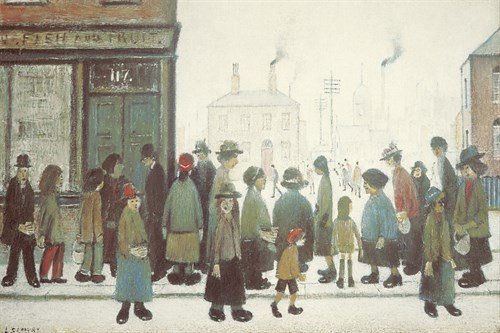
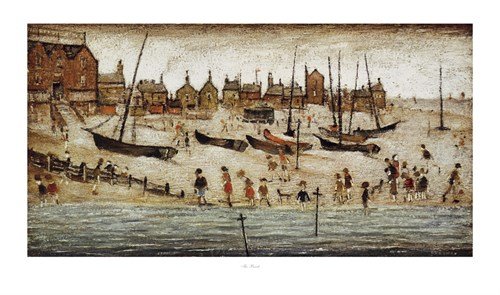
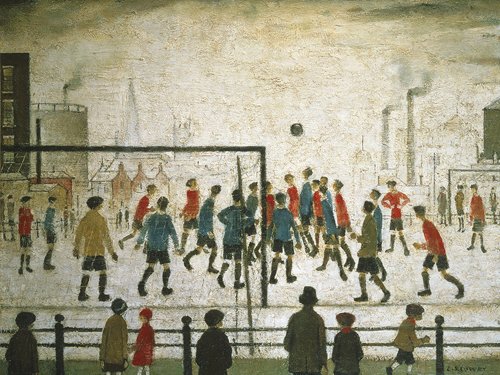
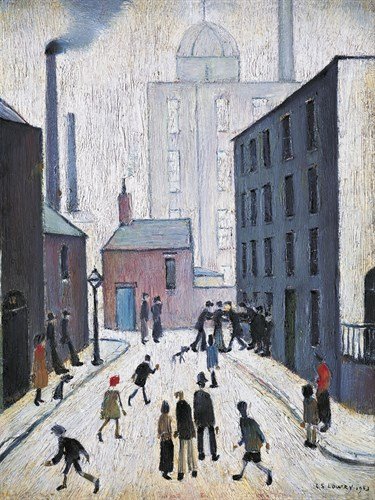
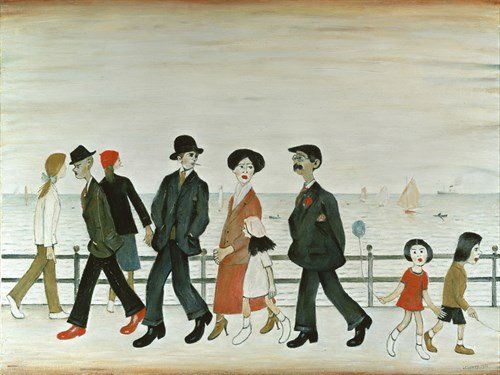
“You don’t need brains to be a painter, just feelings”

